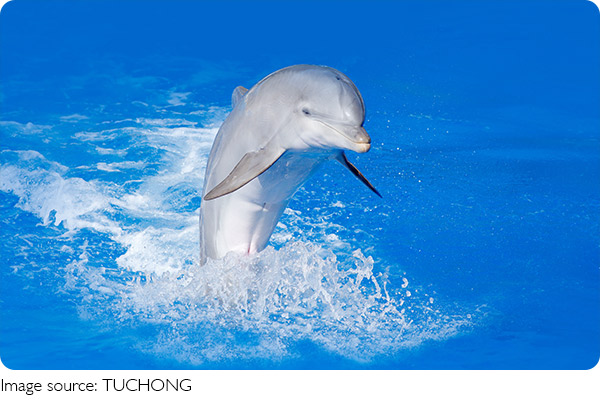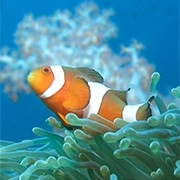Echoes Reveal Depths

Have you ever wondered how dolphins manage to "see" in the dark, murky depths of the ocean, where light barely reaches?
It's not just their sharp eyes that help—they have a secret superpower called echolocation that turns sound into a kind of underwater vision.
Today, let's dive deep into this fascinating ability and uncover how dolphins use it not only to find food but also to connect with each other in their watery world.
What Is Echolocation?
Imagine you're in a pitch-black room. You can't see anything, but if you clap your hands and listen carefully, the echoes bouncing back tell you where the walls or objects are. Dolphins do something similar—but much more advanced.
Echolocation is a biological sonar system. Dolphins send out clicks—short bursts of sound—that travel through the water. When these sound waves hit something, like a fish or a rock, they bounce back as echoes. The dolphin listens carefully to these echoes to build a mental picture of what's around them.
But here's what's amazing: dolphins don't just know where something is—they can also figure out what it is. They can tell the size, shape, speed, and even the texture of objects from these echoes. It's like painting a detailed picture with sound waves.
How Dolphins Produce and Receive Echolocation Sounds
You might think dolphins use their mouths or vocal cords to make those clicking sounds, but it's a bit more complex. Dolphins produce echolocation clicks in a specialized part of their head called the "melon." This melon is a fatty structure on the forehead that focuses the sound waves like a spotlight.
When a dolphin wants to scan its surroundings, it sends clicks from the melon. These clicks shoot forward, travel through water, and when they hit an object, they reflect back. The returning echoes are picked up by the dolphin's lower jaw, which is filled with a fatty pad that conducts sound to the inner ear.
The dolphin's brain then processes these echoes incredibly fast and precisely. Research shows that dolphins can detect differences in echo timing as short as a few thousandths of a second. This allows them to sense objects with remarkable detail, even in total darkness or cloudy water.
The Amazing Details Dolphins Can Detect
Let's break down what dolphins can learn from echolocation echoes:
1. Distance: By measuring how long it takes for the echo to return, dolphins know how far away an object is.
2. Size and Shape: Different shapes reflect sound differently. A fish's smooth, curved body sounds different from a sharp rock or a coral reef.
3. Texture: Dolphins can tell if a surface is smooth or rough, helping them decide whether to approach or avoid it.
4. Movement: Changes in the echo's frequency can reveal if an object is moving towards or away from them, like a fish swimming or a predator lurking.
This level of detail means dolphins don't just find their dinner—they can choose the right type of fish or avoid dangerous obstacles easily.
Social Uses of Echolocation
Echolocation isn't only about hunting or navigation. Dolphins are highly social animals, and they also use sound to communicate and understand their environment socially.
They produce a wide variety of clicks, whistles, and pulses to send messages to other dolphins. Echolocation clicks help them locate each other in large groups, especially when visibility is poor. Dolphins can even recognize individual members by their unique whistle "names."
Scientists have observed that dolphins sometimes cooperate during hunts, using echolocation to coordinate movements and trap prey. This shows not just physical skill but a kind of underwater teamwork and intelligence.

Why Echolocation Is a Game-Changer in the Ocean
The ocean can be a confusing place. Light fades quickly underwater, especially in deeper or murky waters. For most animals, vision alone isn't reliable. Echolocation gives dolphins a huge advantage:
• They can explore areas where eyesight fails.
• They find hidden prey tucked inside crevices or buried in sand.
• They navigate tricky environments like coral reefs without bumping into danger.
• They maintain social bonds over distances where sound travels better than sight.
Without echolocation, dolphins would lose much of their remarkable agility and survival skills.
What Science Tells Us About Dolphin Echolocation
Marine biologists and neuroscientists continue to study how dolphins process echolocation. Studies using advanced recording devices and brain imaging show dolphins' brains are wired to analyze sound in a way humans can hardly imagine.
Dr. Lori Marino, a prominent marine mammal scientist, points out that echolocation is "a sensory ability that combines extraordinary precision with complex social communication." She explains that understanding echolocation helps us appreciate dolphins' intelligence and the need to protect their underwater habitats.
Next time you watch a dolphin leap from the water or hear their clicks underwater, remember this: their incredible ability to "see" with sound opens a whole hidden world to them—a world we are just beginning to understand.
Have you ever thought about how echolocation compares to human technology like sonar or radar? It's a perfect example of nature inspiring innovation. What other animal superpowers fascinate you? Let's keep exploring these wonders together.

 · Animal Team
· Animal Team